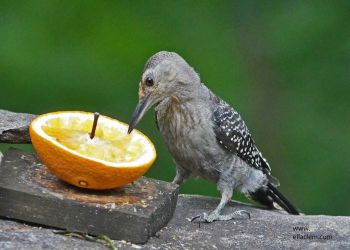(→External Links: Multiple GSearches combined) |
m (→External Links) |
||
| Line 40: | Line 40: | ||
==External Links== | ==External Links== | ||
{{GSearch|"Woodpecker carolinus" {{!}} "Red-bellied Woodpecker"}} | {{GSearch|"Woodpecker carolinus" {{!}} "Red-bellied Woodpecker"}} | ||
| − | {{GS-checked}} | + | {{GS-checked}}1 |
<br /> | <br /> | ||
<br /> | <br /> | ||
[[Category:Birds]] [[Category:Melanerpes]] | [[Category:Birds]] [[Category:Melanerpes]] | ||
Revision as of 20:57, 28 January 2023
- Melanerpes carolinus
Centurus carolinus
Identification
- Length: 9 to 10.5 inches (23-27 cm)
- Wingspan: 15 to 18 inches (38-45.5 cm).
- Back is barred black and white.
- Adults are mainly light gray on the face.
- Male has red crown and nape
- Female has red nape and a red patch above the bill (gray on crown).
- Rosy wash on the belly.
- White wing patches are noticeable when bird is in flight.
Similar species
Golden-fronted Woodpecker which is found in central Texas, south into eastern Mexico, and northern Central America to Nicaragua.
Distribution
Eastern North America (southern Canada to Texas and Florida Keys)
The range is expanding both northward and westward.
Taxonomy
This is a monotypic species[1].
Habitat
Temperate hardwood forests, swampy woods, open deciduous and coniferous forests with a supply of old dead trees.
Behaviour
Diet
They eat insects such as beetles, ants and flies, either in flight or from tree trunks, as well as fruits, seeds and nuts.
Breeding
They make their nests in decayed tree cavities or trees such as elms, maples and willows.
Vocalisation
Chirrup call similar to tree frog, plus an abrupt chuck chuck chuck.
References
- Clements, J. F., T. S. Schulenberg, M. J. Iliff, D. Roberson, T. A. Fredericks, B. L. Sullivan, and C. L. Wood. 2015. The eBird/Clements checklist of birds of the world: v2015, with updates to August 2015. Downloaded from http://www.birds.cornell.edu/clementschecklist/download/
- Handbook of the Birds of the World Alive (retrieved October 2015)
- Wikipedia
Recommended Citation
- BirdForum Opus contributors. (2024) Red-bellied Woodpecker. In: BirdForum, the forum for wild birds and birding. Retrieved 26 April 2024 from https://www.birdforum.net/opus/Red-bellied_Woodpecker
External Links
GSearch checked for 2020 platform.1








